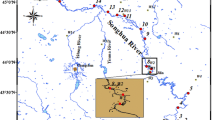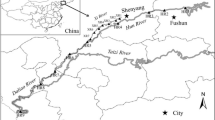Abstract
Residual PEGs in surface river water and sediments were measured at Nakdong River watershed. In this research considering hazards to human and environment, to understand the behavior of PFGs within inorganic materials while moving through river system, and evaluated inter-media distribution characteristics and the influence of river flow from Seonsan to estuary dike of Nakdong River. In surface water, the concentration of PEGs were detected the order as PFOA >PFNA>PFOS>PFHxS>PFOSA, and in sediments the order was PFOS>PFNA=PFOA>PFHxS=PFOSA. Carboxyl series, PFOA and PENA, showed high concentration in surface water, PFOS, PFHxS, and PFOSA were detected with low concentration. The concentration of PFOA and PFNA were relatively high in Nakdong River watershed and it is mainly due to the effects Geumho River.
Similar content being viewed by others
References
Giesy, J. P. & Kannan, K. Perfluorochemical surfactants in the environment.Environ. Sci. Technol. 36, 146A-152A (2002).
Moody, C. A., Martine, J. W., Kwan, W. C., Muir, D. C. G. & Mabury, S. A. Monitoring perfluorinated surfactants in biota and surface water samples following an accidental release of fire-fighting foam into Etobicoke Creek.Environ. Sci. Technol. 36, 545–551 (2002).
OECD. Hazard assessment of Perfluorooctane Sulfonate (PFOS) and its Salts. Unclassified ENV/JMiRD (2002)17/Final. Document No. JTOO1 35607 (2002).
US EPA. Periluorooctyl sulfonates: proposed significant new use rule.Federal Register 65, 62319–62333 (2000).
Hansen, K. J., Johnson, H. O., Eldridge, J. S., Butenhoff, J. L. & Dick, L. A. Quantitative characterization of trace levels of PFOS and PFOA in the Tennessee River.Environ. Sci. Technol. 36, 1681–1685 (2002).
Rostkowski, P.et al. Perfluorinated compounds in streams of the Shihwa industrial zone and Lake Shihwa, South Korea.Environ. Toxicol. Chem. 25, 2374–2380 (2006).
US EPA. Method 537. Determination of Selected Perfluorinated Alkyl Acids in Drinking Water by Solid Phase Extraction and Liquid Chromatography/Tandem Mass Specirometry (LC/MS/MS), EPA/600/R-08/092 (2008).
IS025101, 2009. Water quality — determination of perfluorooctanesulfonate (PFO5) and perfluorooctanoate (PFOA) — method for unfiltered samples using solid phase extraction and liquid chromatogmphy/mass spectrometry. In: The International Organization for Standardization, Geneva, Switzerland, p. 24.
Skutlarek, D., Exner, M. & Färber, H. Perfluorinated surfactants in surface and drinking waters.Environ. Sci. Pollut. Res. 13, 299–307 (2006).
Murakami, M.et al. Groundwater pollution by perfluorinated surfactants in Tokyo.Environ. Sci. Technol. 43, 3480–3486 (2009).
Nations Environmental Programme, UNEP/POPS/COP4/38 (2009).
Yamashita, N.et al. Analysis of perfluorinated acids at parts-per-quadrillion levels in seawater using liquid chromatography-.tandem mass spectrometry.Environ. Sci. Technol. 38, 5522–5528 (2004).
Higgins, C. P., Field, J. A., Criddle, C. S. & Luthy, R. G. Quantitative determination of perfluorochemicals in sediments and domestic sludge.Environ. Sci. Technol. 39, 3946–3956 (2005).
Yamashita, N.et al. A global survey of perfluorinated acids in oceans.Mar. Pollut. Bull. 51, 658–668 (2005).
Prevedouros, K., Cousins, I. T., Buck, R. C. & Korzeniowski, S. H. Sources, fate and transport of perfluorocarboxylates.Environ. Sci. Technol. 40, 32–44 (2006).
Qiu, Y., Fujii, S., Tanaka, S., Nozoe, M. & Kimura, K. Performances of wastewater treatment processes on removal of perfluorochemicals (PFCs).Organohalogen. Comp. 69, 2832–2835 (2007).
Zushi, Y., Takeda, T. & Masunaga, S. Existence of nonpoint source of perfluorinated compounds and their loads in the Tsurumi River basin, Japan.Chemosphere 71, 1566–1573 (2008).
Murakami, M., Shinohara, H. & Takada, H. Evaluation of wastewater and street runoff as sources of perfluorinated surfactants (PFSs).Chemosphere 74. 487–493 (2009).
Becker, A. M., Gerstmann, S. & Frank, H. Perfluorooctanoic acid and perfluorooctane sulfonate in the sediment of the Roter Main Rivei Bayreuth, Germany.Environmental Pollution 156, 818–820 (2008).
Moody, C. A. & Field, J. A. Perfluorinated surfactants and the environmental implications of their use in fire-fighting foams.Environ. Sci. Technol. 34, 3864–3870 (2000).
Boulanger, B., Vargo, J., Schnoor, J. L. & Hombuckle, K. C. Detection of perfluorooctane surfactants in Great Lakes water.Environ. Sci. Technol. 38, 4064–4070 (2004).
Yeung, L. W. Y.et al. A survey of perfluorinated compounds in surface water and biota including dolphins from the Ganges River and in other waterbodies in India.Chemosphere 76, 55–62 (2009).
Saito, N.et al. Perfluorooctane sulfonate concentrations in surface water in Japan.Arch. Environ. Contam. Toxicol. 45, 149–158 (2003).
So, M. K.et al. Perfluorinated compounds in the Pearl River and Yangtze River of China.Chemosphere 68, 2085–2095 (2007).
Yamashita, N.et al. Analysis of perfluorinated acids at parts-per-quadrillion levels in seawater using liquid chromatography-tandem mass spectrometry.Environ. Sci. Technol. 38, 5522–5528 (2004).
Author information
Authors and Affiliations
Corresponding author
Rights and permissions
About this article
Cite this article
Cho, CR., Cho, H.s. & Kannan, K. Residual characteristics of periluorinated compounds in Nakdong River watershed. Toxicol. Environ. Health. Sci. 2, 60–72 (2010). https://doi.org/10.1007/BF03216514
Accepted:
Issue Date:
DOI: https://doi.org/10.1007/BF03216514




